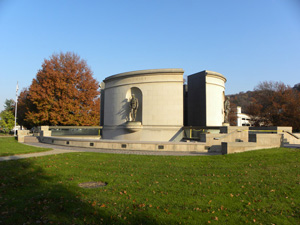

Remember...
Donald Robert McCloud
1920-1941
"I fear all we have done is to awaken a sleeping giant and fill him with a terrible resolve."
attributed to Japanese Admiral Isoroku Yamamoto
 |
Remember...Donald Robert McCloud
|
Navy Fire Controlman Second Class (FC2C) Donald Robert McCloud hailed from Monaville in Logan County, West Virginia. He was born on November 18, 1920, in Dingess, Mingo County, to Anderson McCloud and Dicie Ellen Mullens McCloud. Anderson was a tipple man in the coal mines, which accounts for the fact that the family lived in several coal mining towns. Dicie was eleven years her husband's junior and had been born in Kentucky (the McClouds always lived in those counties hugging the Kentucky border). Donald grew up with two older brothers, Curtis Jennings McCloud (1909-1995) and Clarence Andy McCloud (1913-1992). The three boys joined an older sister Jessie McCloud (1906-1997; married name: Jenkins).
Donald Robert McCloud came of age during the Great Depression. Although he attended high school in Logan County, the expectation was that after his school career, he would work in the mines. That is what young men in Logan County did, unless they were more adventurous and left the state to find employment elsewhere or joined the military. Donald chose the latter and entered the U.S. Navy. In correspondence with the West Virginia Veterans Memorial Foundation, his sister Jessie said, "Many years have passed, . . . and he was only 18." It seems logical to infer that he joined the military right out of high school, and this is corroborated by the remembrances of some of his close friends.
An article in the Charleston Sunday Gazette-Mail tells the story of Donald's enlistment. John and Joseph Triolo, high-school friends of Donald, had already joined the Navy and were stationed on the USS Oklahoma. While on leave at home, they made such an impression on Donald, they recruited him to join them. After basic training, he requested an assignment on the Oklahoma. The three young men headed to the Pacific aboard the WWI-era battleship. The article goes on to say:
Because of his good test scores, McCloud was put into the fire control division, working below decks. Normally in those days a new sailor worked as deck crew, topside. Only after you proved yourself did you get to move into a specific career field such as fire control, which worked on the large guns.
Joseph Triolo was the first to leave the Oklahoma; later in 1938 he moved to another ship in the Pacific fleet. John stayed with the ship until November of 1941, when he headed for Norfolk, Virginia, to attend aviation maintenance school. Donald was offered the chance to leave the ill-fated ship, but declined. (Van Harl, "Coal Mine, Moonshine or Move On down the Line," Sunday Gazette-Mail, 7 December 2008.)
There's more to the Triolo/McCloud story. Joe Triolo was aboard the USS Tangier, a seaplane tender sailing in and out of Pearl Harbor. When the Oklahoma pulled into the harbor, the two high school friends agreed to meet. Joe and Donald got together after the Oklahoma baseball team played a game on December 6. Donald suggested they get a couple of beers, but Joe was broke, so McCloud lent him two dollars. At the end of the evening at the enlisted men's club, the two parted ways, never to see each other again. According to Van Harl, "Not all combat-killed Americans are buried where family can easily visit and remember." But Joe Triolo never forgot his friend and vowed, "If money spends in heaven, . . . [he] will repay his friend the $2."
Article prepared by Patricia Richards McClure
June 2019

West Virginia Archives and History welcomes any additional information that can be provided about these veterans, including photographs, family names, letters and other relevant personal history.